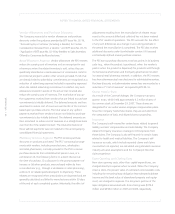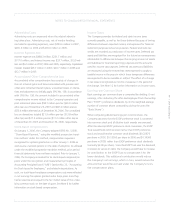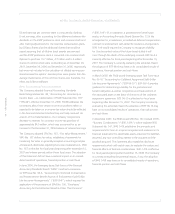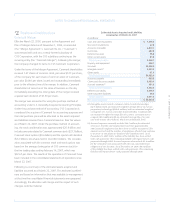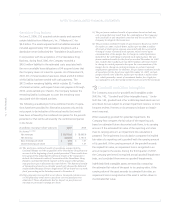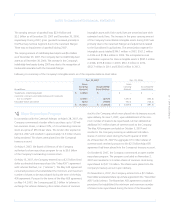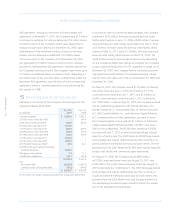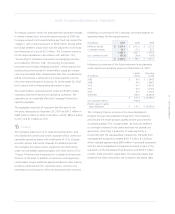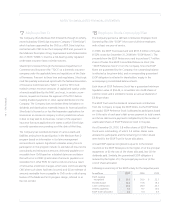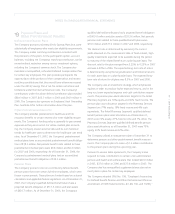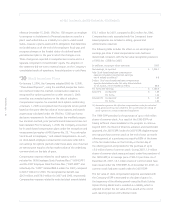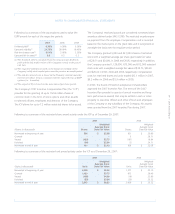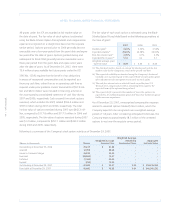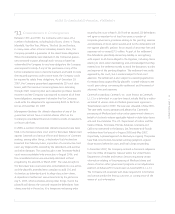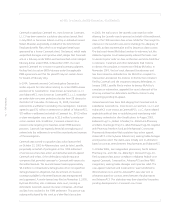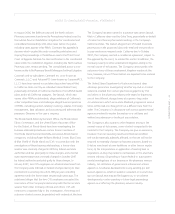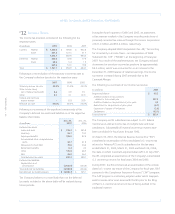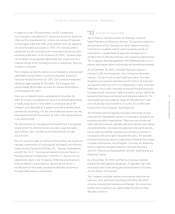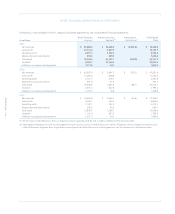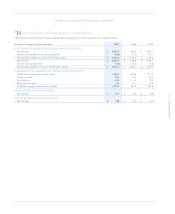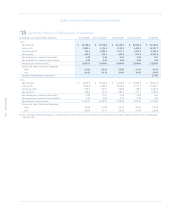CVS 2007 Annual Report Download - page 62
Download and view the complete annual report
Please find page 62 of the 2007 CVS annual report below. You can navigate through the pages in the report by either clicking on the pages listed below, or by using the keyword search tool below to find specific information within the annual report.
58 I CVS Caremark
effective December 15, 2006. SFAS No. 158 requires an employer
to recognize in its statement of financial position an asset for a
plan’s overfunded status or a liability for a plan’s underfunded
status, measure a plan’s assets and its obligations that determine
its funded status as of the end of the employer’s fiscal year, and
recognize changes in the funded status of a defined benefit
postretirement plan in the year in which the changes occur.
Those changes are reported in comprehensive income and in a
separate component of shareholders’ equity. The adoption of
this statement did not have a material impact on the Company’s
consolidated results of operations, financial position or cash flows.
Stock Incentive Plans
On January 1, 2006, the Company adopted SFAS No. 123(R),
“Share-Based Payment”, using the modified prospective transi-
tion method. Under this method, compensation expense is
recognized for options granted on or after January 1, 2006
as well as any unvested options on the date of adoption.
Compensation expense for unvested stock options outstanding
at January 1, 2006 is recognized over the requisite service period
based on the grant-date fair value of those options and awards
as previously calculated under the SFAS No. 123(R) pro forma
disclosure requirements. As allowed under the modified prospec-
tive transition method, prior period financial statements have not
been restated. Prior to January 1, 2006, the Company accounted
for its stock-based compensation plans under the recognition and
measurement principles of APB Opinion No. 25, “Accounting for
Stock Issued to Employees,” and related interpretations. As such,
no stock-based employee compensation costs were reflected in
net earnings for options granted under those plans since they had
an exercise price equal to the fair market value of the underlying
common stock on the date of grant.
Compensation expense related to stock options, which
includes the 1999 Employee Stock Purchase Plan (“1999 ESPP”)
and the 2007 Employee Stock Purchase Plan (“2007 ESPP” and
collectively the “ESPP”) totaled $84.5 million for 2007, compared
to $60.7 million for 2006. The recognized tax benefit was
$26.9 million and $18.0 million for 2007 and 2006, respectively.
Compensation expense related to restricted stock awards totaled
$12.1 million for 2007, compared to $9.2 million for 2006.
Compensation costs associated with the Company’s share-
based payments are included in selling, general and
administrative expenses.
The following table includes the effect on net earnings and
earnings per share if stock compensation costs had been
determined consistent with the fair value recognition provisions
of SFAS No. 123(R) for 2005:
In millions, except per share amounts 2005
Net earnings, as reported $ 1,224.7
Add: Stock-based employee compensation
expense included in reported net earnings,
net of related tax effects(1) 4.8
Deduct: Total stock-based employee compensation
expense determined under fair value based method
for all awards, net of related tax effects 48.6
Pro forma net earnings $ 1,180.9
Basic EPS: As reported $ 1.49
Pro forma 1.44
Diluted EPS: As reported $ 1.45
Pro forma 1.40
(1) Amounts represent the after-tax compensation costs for restricted
stock grants and expense related to the acceleration of vesting of
stock options on certain terminated employees.
The 1999 ESPP provides for the purchase of up to 14.8 million
shares of common stock. As a result of the 1999 ESPP not
having sufficient shares available for the program to continue
beyond 2007, the Board of Directors adopted, and shareholders
approved, the 2007 ESPP. Under the 2007 ESPP, eligible employ-
ees may purchase common stock at the end of each six-month
offering period, at a purchase price equal to 85% of the lower
of the fair market value on the first day or the last day of
the offering period and provides for the purchase of up to
15.0 million shares of common stock. During 2007, 1.9 million
shares of common stock were purchased, under the provisions of
the 1999 ESPP, at an average price of $25.10 per share. As of
December 29, 2007, 14.1 million shares of common stock have
been issued under the 1999 ESPP. As of December 29, 2007, no
common stock had been issued under the 2007 ESPP.
The fair value of stock compensation expense associated with
the Company’s ESPP is estimated on the date of grant (i.e.,
the beginning of the offering period) using the Black-Scholes
Option Pricing Model and is recorded as a liability, which is
adjusted to reflect the fair value of the award at the end of
each reporting period until settlement date.
#10


